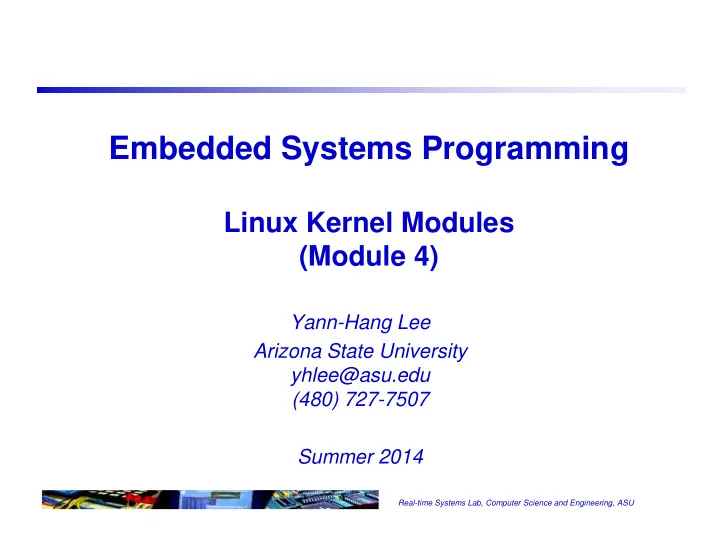

Embedded Systems Programming Linux Kernel Modules (Module 4) Yann-Hang Lee Arizona State University yhlee@asu.edu (480) 727-7507 Summer 2014 Real-time Systems Lab, Computer Science and Engineering, ASU
What is “kernel” The basic component of an operating system to provide the lowest-level abstraction layer for the resources (especially processors and I/O devices). available to application processes through inter-process communication mechanisms and system calls Kernel space and user space What are system calls and how many are they? Which are systems calls – cc, make, ls, cat, grep, read, open, printf, malloc, etc. How can we set the baud rate of a serial port? Configuration of a hyperterminal stty -F /dev/ttyS2 ospeed 38400 Ioctl to get and set terminal attributes (defined in struct termios) The mechanism of making system calls and passing parameters 1 Real-time Systems Lab, Computer Science and Engineering, ASU
Kernel Components Process Management Process life cycle, Inter Process Communication, I/O Scheduling (long-term, short-term) Memory Management Virtual memory, management, security File System File system tree, management, security Device Control Almost every system operation maps to a physical device The code used to do those operations is called Device Driver Networking Collect incoming packets and De-Multiplexing them Deliver outgoing packets 2 Real-time Systems Lab, Computer Science and Engineering, ASU
Memory Spaces (1) The logical address space of a process is divided into two parts – 0x00000000 to PAGE_OFFSET-1 can be addressed in either user or kernel mode – PAGE_OFFSET to 0xffffffff can be addressed only in kernel mode – PAGE_OFFSET is usually 0xc00000000 Peripheral devices are controlled by writing and reading their registers. Where are these registers? I/O Port: request an IO port region and inb (outb) from <asm/io.h> I/O Memory: Request a memory region Devices at physical addresses which have to be mapped to virtual addresses for software to access. 3 Real-time Systems Lab, Computer Science and Engineering, ASU
Memory Spaces (2) Physical memory Virtual memory (user and kernel space) Linux ARM -- Linux/Documentation/arm/memory.txt (X86 virtual memory layout) 4 Real-time Systems Lab, Computer Science and Engineering, ASU
Linux Kernel Modules Modules can be compiled and dynamically linked into kernel address space. Useful for device drivers that need not always be resident until needed. (why?) Extend the functionality of the kernel without rebuilding and rebooting the system. Kernel keeps a symbol table Symbols accessible to kernel-loadable modules appear in /proc/kallsyms . EXPORT_SYMBOL(), which exports to any loadable module, or EXPORT_SYMBOL_GPL(), which exports only to GPL-licensed modules. Can call any functions exported by the kernel no library is linked to modules 5 Real-time Systems Lab, Computer Science and Engineering, ASU
Kernel Modules Pieces of code that can be loaded and unloaded into the kernel. a module registers itself in order to serve future requests Is a part of kernel – printf or printk An example module #include <linux/module.h> // Needed by all modules #include <linux/kernel.h> // Needed for KERN_ALERT #include <linux/init.h> // Needed for the macros static int hello_2_init(void) { printk(KERN_ALERT "Hello, world 2\n"); return 0; } static void hello_2_exit(void) { printk(KERN_ALERT "Goodbye, world 2\n"); } module_init(hello_2_init); module_exit(hello_2_exit); (Add code/Makefile example) 6 Real-time Systems Lab, Computer Science and Engineering, ASU
Programs for Linking and Unlinking Modules insmod Invokes create_module( ) and query_module( ) system calls Using the kernel symbol table, the module symbol tables, and the address returned by the create_module( ) system call, relocates the object code. Allocates a memory area in the User Mode address space and loads with a copy of the module object Invokes the init_module( ) system call, passing to it the address of the User Mode memory area Releases the User Mode memory area and terminates lsmod rmmod modprobe loads a module into the kernel. check any module dependency and load any other modules that are required – stacking of modules 7 Real-time Systems Lab, Computer Science and Engineering, ASU
Module Implementation The kernel considers only modules that have been loaded into RAM by the insmod program and for each of them allocates memory area containing: a module object null terminated string that represents module's name the code that implements the functions of the module Building Linux kbuild obj-m make -C ~/kernel-2.6 M=`pwd` modules to build modules.ko “M=“ is recognized and kbuild is used ~/kernel-2.6 is the kernel source directory pwd ?? 8 Real-time Systems Lab, Computer Science and Engineering, ASU
Supplementary Slides Real-time Systems Lab, Computer Science and Engineering, ASU
HelloWorld Kernel Module Example (1) /* Hello World kernel module program */ #include <linux/init.h> #include <linux/module.h> #include <linux/time.h> #include <linux/delay.h> static int hello_init(void) { int i; struct timeval curTime; // keeps the time since the Epoch struct tm bkd_time; // containing a calendar date and time for (i=0; i<10; i++) { do_gettimeofday(&curTime); time_to_tm(curTime.tv_sec, 0, &bkd_time); printk(KERN_ALERT "Hello, world. The current time is: %d:%d:%d:%ld\n", bkd_time.tm_hour, bkd_time.tm_min, bkd_time.tm_sec, curTime.tv_usec); msleep(i*1000); } } static void hello_exit(void) { printk(KERN_ALERT "Goodbye, cruel world\n"); } module_init(hello_init); module_exit(hello_exit); 10 Real-time Systems Lab, Computer Science and Engineering, ASU
HelloWorld Kernel Module Example (2) # Makefile for Hello World kernel module CC = i586-poky-linux-gcc ARCH = x86 CROSS_COMPILE = i586-poky-linux- SROOT=/opt/clanton-full/1.4.2/sysroots/i586-poky-linux/ obj-m = HelloModule.o all: make ARCH=$(ARCH) CROSS_COMPILE=$(CROSS_COMPILE) -C $(SROOT)/usr/src/kernel M=$(PWD) modules ---- copy to the target scp HelloModule.ko root@10.218.101.25:/home/....... ---- install and remove the module insmod HelloModule.ko rmmod HelloModule 11 Real-time Systems Lab, Computer Science and Engineering, ASU
Recommend
More recommend